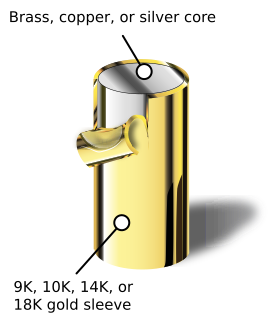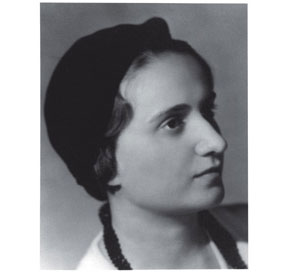Related Research Articles

Costume jewelry includes a range of decorative items worn for personal adornment that are manufactured as less expensive ornamentation to complement a particular fashionable outfit or garment as opposed to "real" (fine) jewelry, which is more costly and which may be regarded primarily as collectibles, keepsakes, or investments.

Jewellery or jewelry consists of decorative items worn for personal adornment, such as brooches, rings, necklaces, earrings, pendants, bracelets, and cufflinks. Jewellery may be attached to the body or the clothes. From a western perspective, the term is restricted to durable ornaments, excluding flowers for example. For many centuries metal, often combined with gemstones, has been the normal material for jewellery, but other materials such as shells and other plant materials may be used. It is one of the oldest type of archaeological artefact – with 100,000-year-old beads made from Nassarius shells thought to be the oldest known jewellery. The basic forms of jewellery vary between cultures but are often extremely long-lived; in European cultures the most common forms of jewellery listed above have persisted since ancient times, while other forms such as adornments for the nose or ankle, important in other cultures, are much less common.

An adornment is generally an accessory or ornament worn to enhance the beauty or status of the wearer. They are often worn to embellish, enhance, or distinguish the wearer, and to define cultural, social, or religious status within a specific community. When worn to show economic status, the items are often either rare or prohibitively expensive to others. Adornments are usually colourful, and worn to attract attention.
Talia Rose Shire is an American actress best known for her roles as Connie Corleone in The Godfather films and Adrian Balboa in the Rocky series. For her work in The Godfather Part II and Rocky, Shire was nominated for two Academy Awards for Best Supporting Actress and Best Actress, respectively, and for the Golden Globe Award for Best Actress in a Drama for her role in Rocky.

Nickel silver, Maillechort, German silver, Argentan, new silver, nickel brass, albata, alpacca, is a copper alloy with nickel and often zinc. The usual formulation is 60% copper, 20% nickel and 20% zinc. Nickel silver is named due to its silvery appearance, but it contains no elemental silver unless plated. The name "German silver" refers to its development by 19th-century German metalworkers from the Chinese alloy known as paktong or baitong (白銅). All modern, commercially important nickel silvers contain significant amounts of zinc, and are sometimes considered a subset of brass.

Macramé is a form of textile produced using knotting techniques.

Bunad is a Norwegian umbrella term encompassing, in its broadest sense, a range of both traditional rural clothes as well as modern 20th-century folk costumes. In its narrow sense the word bunad refers only to clothes designed in the early 20th century that are loosely based on traditional costumes. The word bunad in itself is a 20th-century invention.

A rhinestone, paste or diamante is a diamond simulant originally made from rock crystal but since the 19th century from crystal glass or polymers such as acrylic.
Pennino may refer to:

Serbian traditional clothing, also called as Serbian national costume or Serbian dress, refers to the traditional clothing worn by Serbs living in Serbia, Croatia, Bosnia and Herzegovina, Montenegro, and the extended Serbian diaspora communities in Austra, Australia, Bulgaria, Canada, France, Germany, Greece, Hungary, North Macedonia, Romania, Russia, Slovenia, United States, etc. Like any traditional dress of a nation or culture, it has been lost to the advent of urbanization, industrialization, and the growing market of international clothing trends. The wide range of regional folk costumes show influence from historical Austrian, Hungarian, German, Italian, and Ottoman Turkish presence. Nonetheless, the costumes are still a pinnacle part of Serbian folk culture. From the 19th century and onwards, Serbs have adopted western-styled clothing. This change has started in larger settlements such as cities and towns, although it was not uncommon to see rural women in traditional working costumes all the way until the end of President Josip Broz Tito's term. Today, these national costumes are only worn by some elderly in rural areas but are most often worn with connection to special events and celebrations, mostly at ethnic festivals, religious and national holidays, weddings, tourist attractions, and by dancing groups who dance the traditional Serbian kolo, or circle dance.

Kenneth Jay Lane was an American costume jewelry designer.

Gold-filled jewelry is jewelry composed of a solid layer of gold mechanically bonded to a base of either sterling silver or some base metal. The related terms "rolled gold plate" and "gold overlay" may legally be used in some contexts if the layer of gold constitutes less than 5% of the item's weight.

A costume designer is a person who designs costumes for a film, stage production or television show. The role of the costume designer is to create the characters' outfits/costumes and balance the scenes with texture and colour, etc. The costume designer works alongside the director, scenic, lighting designer, sound designer, and other creative personnel. The costume designer may also collaborate with hair stylist, wig master, or makeup artist. In European theatre, the role is different, as the theatre designer usually designs both costume and scenic elements.
Batavia Street Gang was a New York independent street gang based in the Fourth Ward during the 1890s. Affiliated with the Eastman Gang during the turn of the 20th century, they were rivals of the Cherry Hill Gang throughout the previous decade. During one incident, five members of the gang were arrested for breaking into Seigel's jewelry store in order to purchase costumes for the Sullivan ball at New Irving Hall in an attempt to out do their rivals, who were known to be "dandies", had announced they would be attending in extravagant evening clothes.

Tarina Tarantino is an American costume jewelry and accessory designer, based in Los Angeles, California. Known for her flamboyant pink hair, she has been described as having "a pretty cult-like following here in LA" and as "the haute designer of playful jewelry for grown women".
Robert Goossens was a French jeweller who became known as Monsieur Bijou. The son of a metal foundry worker, he was born in Paris, France. In his younger years, he served an apprenticeship in jewelry making, perfecting the techniques of casting, engraving, and embossing semi-precious and simulated stones into gold and silver metals. In his decades of creating fine jewelry, Goossens mixed the genuine stones with the fakes, a blend of the artificial gems with the semi-precious for clients including Coco Chanel, Cristóbal Balenciaga, Yves Saint Laurent, Madame Grès, Christian Dior and others.

Miriam Haskell was an American designer of costume jewelry. With creative partner Frank Hess, she designed affordable pieces from 1920 through the 1960s. Her vintage items are eagerly collected and the namesake company, which first displayed her jewelry in New York City's McAlpin Hotel, continues. It is currently listed as Haskell Jewels, LLC.

Marcasite jewelry is jewelry made using cut & polished pieces of pyrite as gemstone, and not, as the name suggests, from marcasite.
Cadoro, or Cadoro Jewels Corporation, was a Manhattan-based jewelry company founded in 1954 by Steven Brody and Daniel Stoenescu, specialising in fashionable costume jewelry sold via department stores such as Neiman Marcus and Saks Fifth Avenue. The company closed in 1987 following Brody's retirement as president.

The Ethnographic Museum is located at 14 Ivan Mažuranić Square in Zagreb, Croatia. It was founded in 1919 by Salamon Berger. It lies in the Secession building of the one-time Trades Hall of 1903, designed by the architect Vjekoslav Bastl. The statues in the central part of the façade are the work of Rudolf Valdec. The frescoes on the interior part of the cupola were painted by Oton Iveković.
References
- Pennino Jewelry Three Neapolitan Princes and the Legacy of Pennino
- Judith Miller (16 April 2007). POCKET COLLECTIBLES: Costume Jewelry. DK Publishing. pp. 177–178. ISBN 978-0-7566-4179-5.
| This United States retail business article is a stub. You can help Wikipedia by expanding it. |